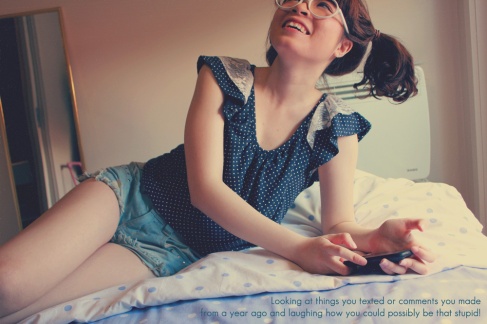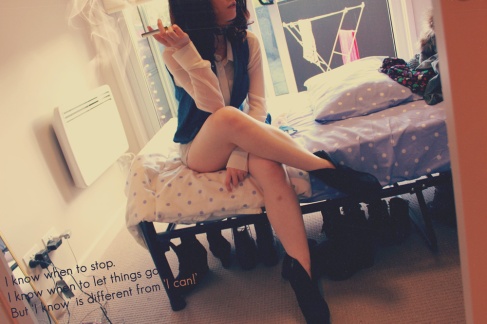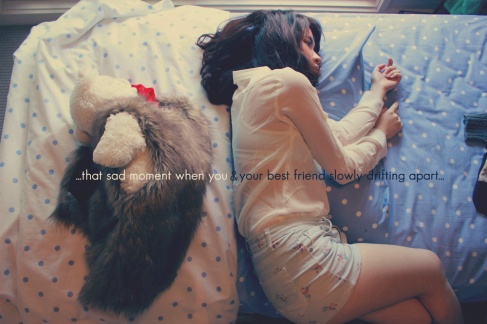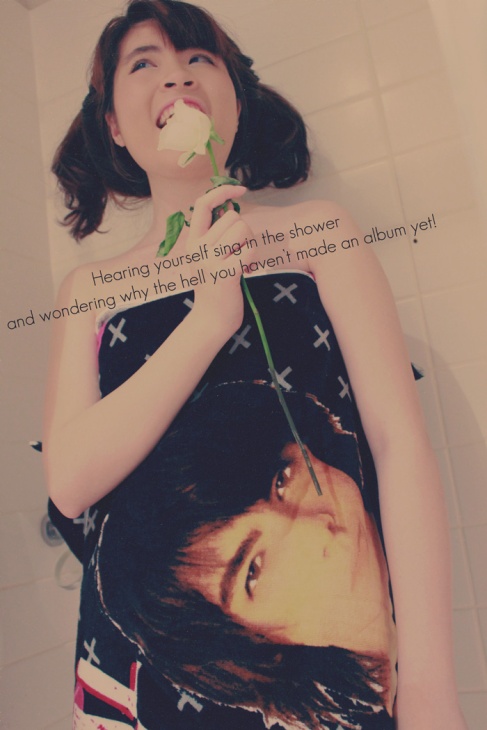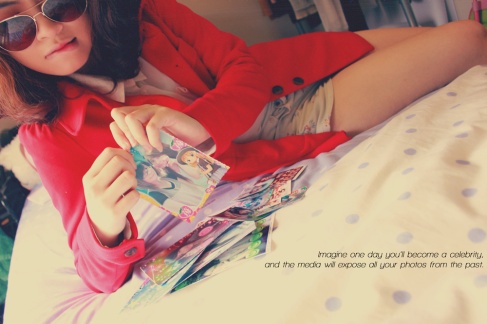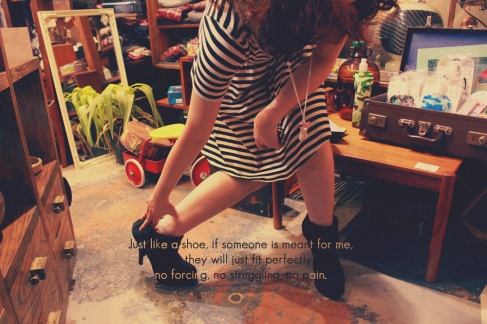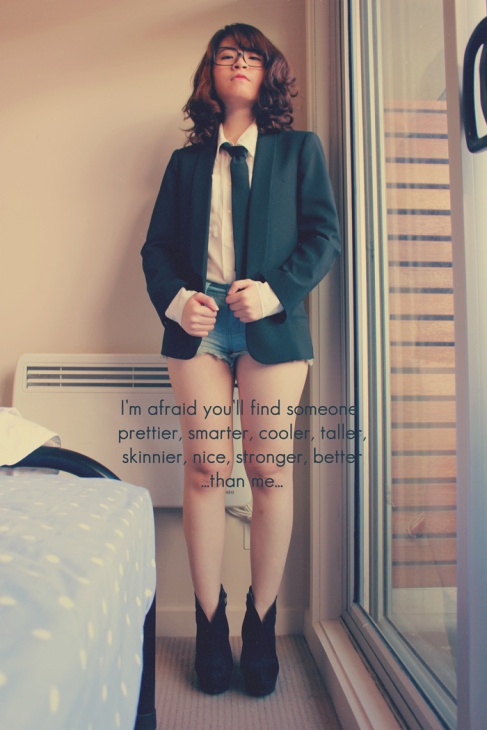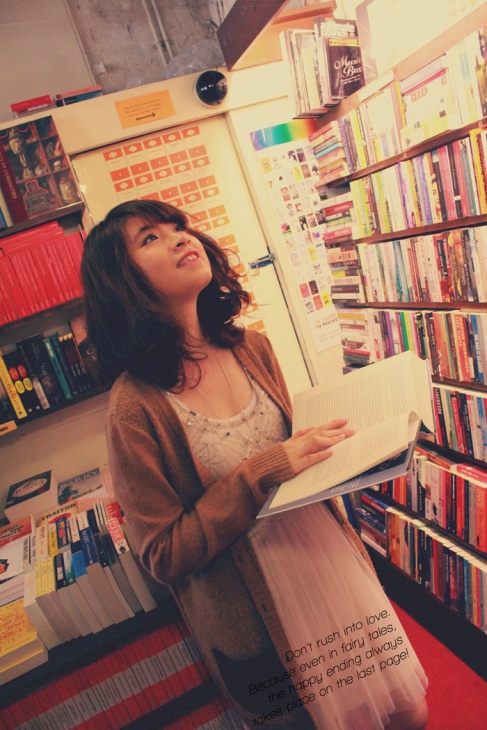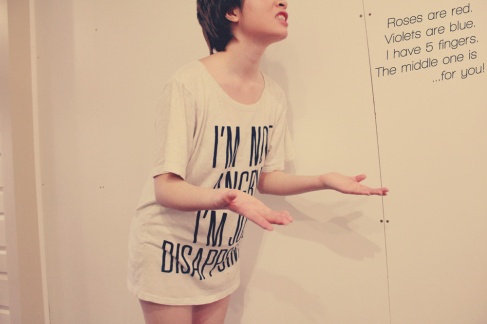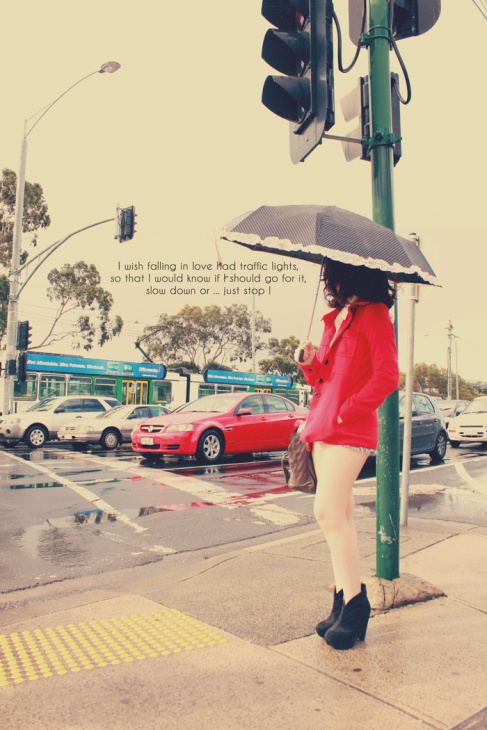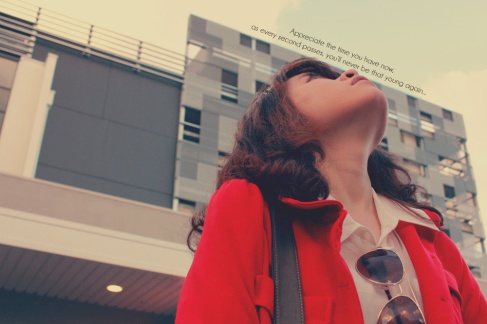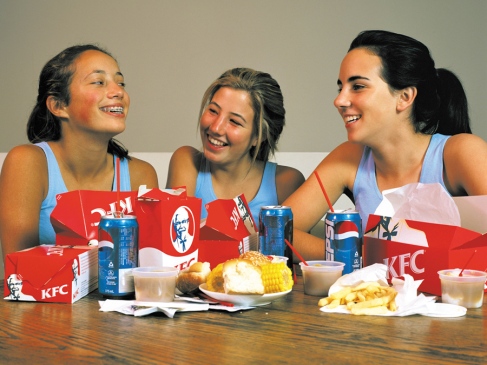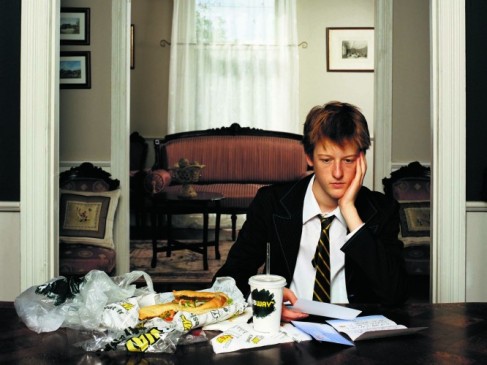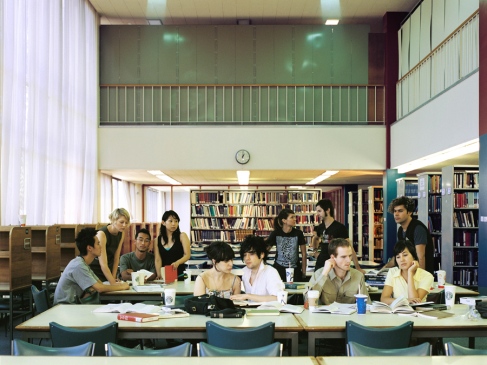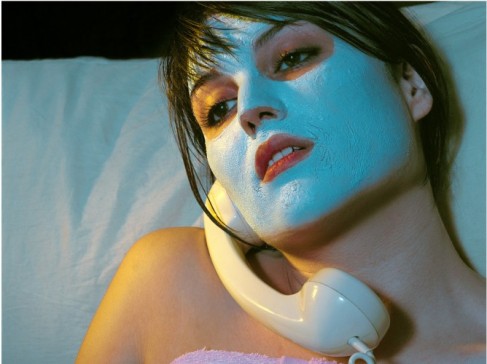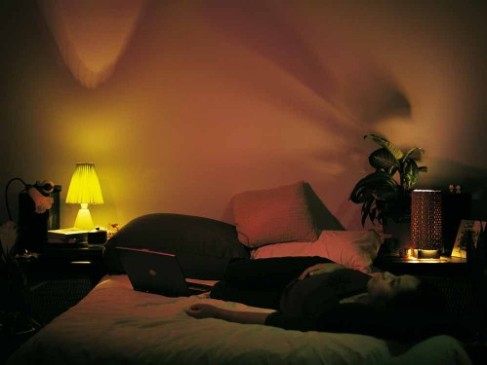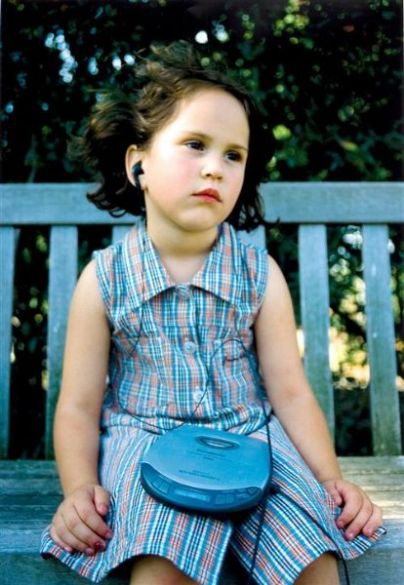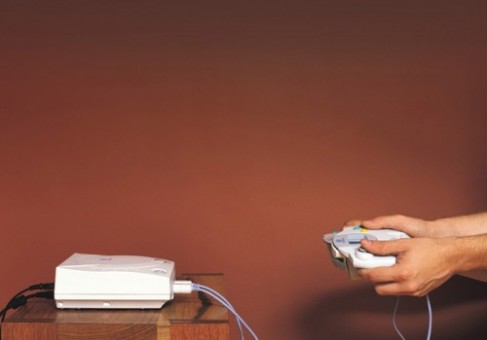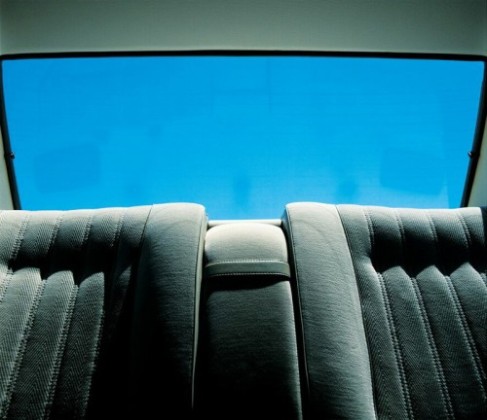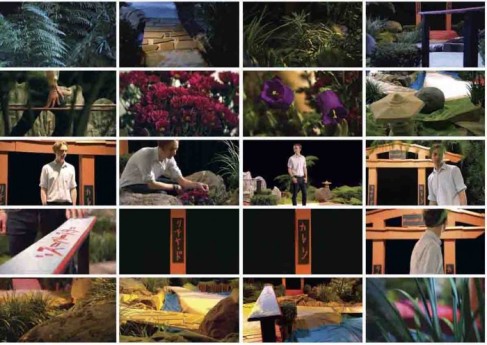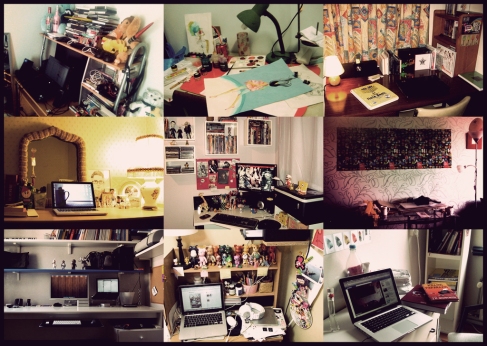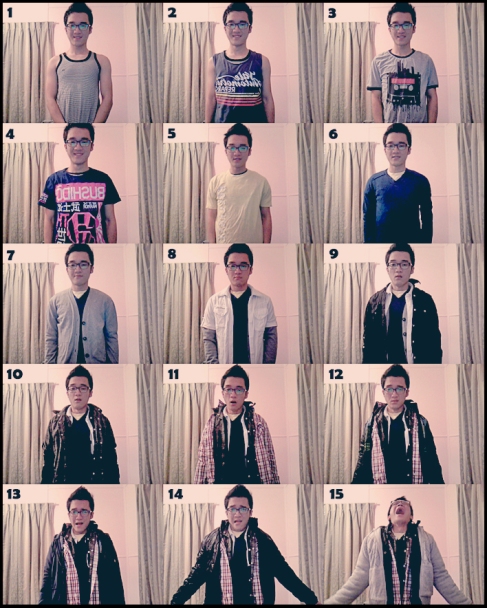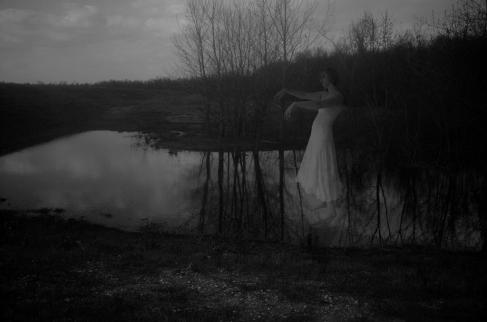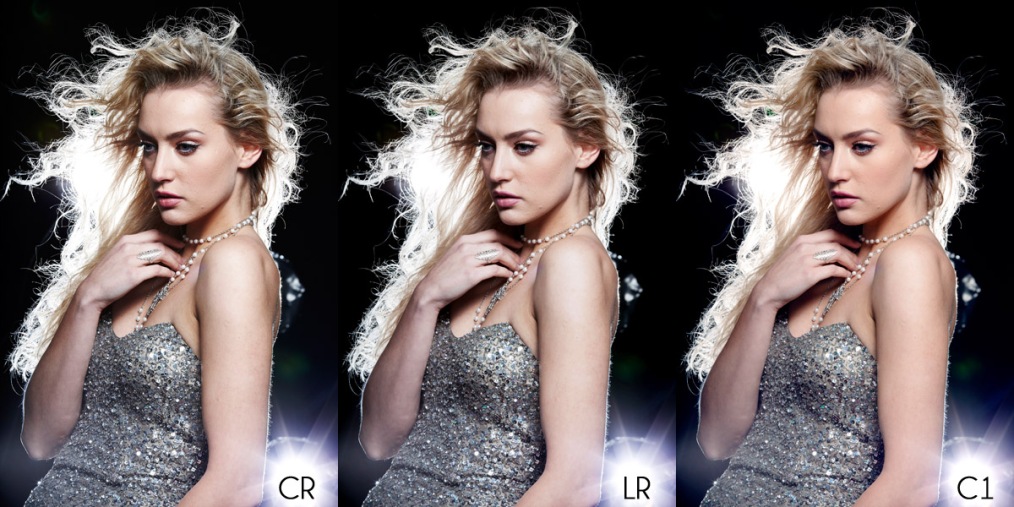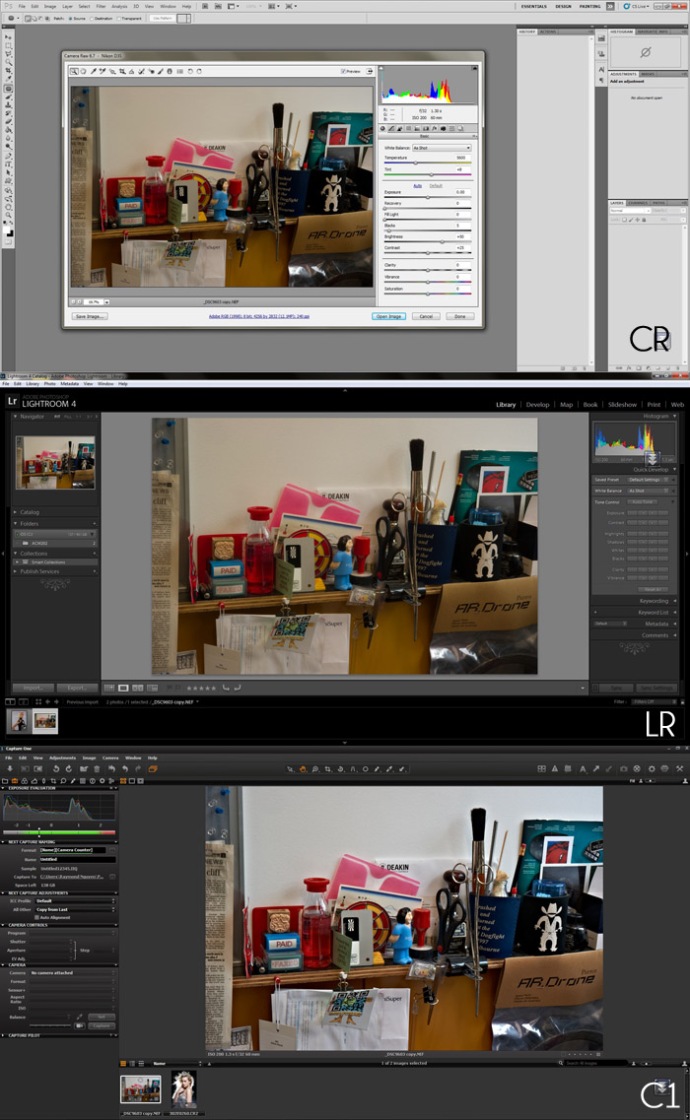Star Artworks!, a set on Flickr.
Darren Sylvester
With a sprawling practice that involves photography, video, sculpture, music & performance, Darren Sylvester is considered one of Australia’s promising artists. He was born in Sydney in 1974 and currently lives and works in Melbourne. He completed a Master of Fine Art degree at Monash University in 2010. His works are held in a number of major public collections such as National Gallery of Australia, Art Gallery of New South Wales…
Sylvester’s photographic practice is internationally well-known for the way he creates narrative-driven scenarios from daily life. The characters in his photographs are usually emotionally taut and conflicted, set in a highly controlled environment in which every detail has been storyboarded, choreographed. His photographs are kind of ambiguous and challenging to interpret. However generally, his works involve exploring young lives and furthermore referring to universal issues such as the fallibility of relationships, urban alienation, the passing of time, mortality…
Interestingly, those themes are evoked and composed around popular clichés and icons of consumer culture such as KFC, Starbucks… which act as a foreground. This has become a distinctive feature of Sylvester’s works. Because of this, Sylvester is misinterpreted as a critique of consumer culture however he explained that this is what people actually do, the brands are ubiquitous and we all consume them and he said that people who thinks his work is a critique of consumerism is out of step with real world (Sylvester, D in Walker, W 2008). For example in this picture, three school girls get together for a KFC feast with their smiles looking somehow fake and uncanny. The intent is to not examine western consumer culture in relation with junk foods but actually is to point out that junk food are embedded in some moments of our life, he’s likely to question about the duration of friendship in comparison with the fleeting nature of fast food.
If all we have is each other, that’s OK! (2003)
Sylvester emphasised that at least one object of popular culture is around us when we encounter something in our life. In this picture, the kid went home and read a break-up letter from his girlfriend, this moment attaches with the Subway that he’s just bought. So, by placing the products of popular culture in relation to people, Sylvester shows how the most disposable elements of a disposable culture can be embodied with emotional intensity.
Your first love is your last love (2005)
Our future was ours shows a cluster of students studying in library with fast food around them; they are glancing around, scoping each other. The title speaks about both their past and future. The implication of this title is to transform this time of their lives (studying) into a truism about life and living. Every university students always holds ambition about their future, their career. However, those ambitions take long time to be achieved and are wasted because they have to work in an unrelated field to cover their study and living expenses. They dream of a future after graduating, however that future never arrives and the job at the fast food restaurant remains with them, to some people, working in places like those become their lives. By showing the interaction between people and objects of popular culture, Sylvester wants to explore the way often banal products can have profound effect on our lives (Sylvester, D in Hawkins, S 2008).
Our future was ours (2005)
Sylvester’s photographs employ a form of Classicism by adapting the techniques of advertising and late Twentieth Century pop music to the predicament of making contemporary art (Travis, L 1999). Like advertisements, his photographs are highly directed and precisely staged with striking and direct style. Based on an explicit scenario, he constructs every photograph painstakingly like a commercial shoot, fully prepared from sketch, storyboard to make-up and digital editing without leaving leave anything to chance. On the other side, he describes his works as like pop songs, “the glossier, the shinier and the better looking it is, people find that really attractive” though “the lyrics or the meaning of the work has quite an underlying sense of bittersweet to it” (Sylvester, D in Beck, C 2006). This picture for example, inspired from the 1970s music duo The Carpenters whose melancholy lyrics were conveyed by sleek pop melodies, depicts a young woman with a facial mask looking distracted. The title Just Death is true creates a connection to mortality, also implies the major obsessions of young people, beauty and aging.
Just Death is true (2000)
Through the visual language of advertising attached with titles that sound like slogans from an advertising campaign, or lyrics from a pop song, he represents the themes of isolation, freedom, relationship and death in conjunction with human condition in the 21st century, where people are technology-orientated and mediated by mobile phones, computers, cars, stereos, monitoring system.
These pictures express the emergence of technology as a way of distancing people from the world. Audiences are able to see Sylvester’s ability to transform the complexity of emotional human condition to a generic, universal but emotive visual works.
Humans evolve to be completely new
Humans evolve to break and disappear (2005)
No longer exposed to problems or tension (1999)
To help each other physically is to help each other emotionally (2000)
The photograph below shows a woman sitting in a car. She has a certain impression on her face, she looks confused. The title is ‘They return to you in song’ leads audience to think she is probably listening to something on the car radio and it has sparked a memory. This photo was taken in 2001 when technology became emergent in our life, it evokes in audience the feeling of nostalgia, it reminds us something belong to the past that we almost forget.
They return to you in song (2001)
We Can Go Anywhere, We Can Do Anything represents one of the most predominant themes of late-Twentieth Century life – the car as a metaphor for emotional and social freedom and isolation. The cropped image of the car seats conveys a curious sense of expansiveness. The view is enclosed and brings to mind a positive vision of the car as speeding us forward into a more exciting future.
We Can Go Anywhere; We Can Do Anything (1999)
Sylvester has various musical practices including the Bruce Springsteen-inspired video Time keeps running, backing music for the exhibition ‘Remote control: Contemporary Photo-media’ at National Gallery of Victoria… An interesting fact in Sylvester’s music practice is that he is an obsessive fan of the pop duo the Carpenters; originally he made an album as a backing music for his gallery in which he recreated the Carpenters’s back garden from the 1970s, however it turned out to be a commercial pop album, the album was called ‘I Was The Last in The Carpenters’ Garden’.
To sum up, Sylvester’s photographic practice is unique that he borrows the universalisation, emotive potential of advertising photography, but turns its function from consumerism to encourage us to make sense of them based on our own experiences of life.
Still cut from ‘I Was The Last in The Carpenters’ Garden’ (2008)
REFERENCES
Australian Art Collector 2006, ‘Darren Sylvester: The Right Stuff’, issue 36, April-June.
Beck, C 2006, ‘Double Exposure’, The Age, 22 April, p. 11.
Hawkins, S 2008, ‘Life’s deep-felt banality’, The Weekend Australian Financial Review, 19-20 July 2008, p. 35.
Interview with Darren Sylvester the photographer, musician, painter, sculptor 2010, Lifelounge, <http://www.lifelounge.com.au/art-and-design/interview/interview-with-darren-sylvester-the-photographer,-musician,-painter,-sculptor.aspx>, retrieved 25th April 2012.
Nelson, R 2007, ‘Darren Sylvester’, The Age, <http://www.theage.com.au/news/arts-reviews/beauty-satire/2007/09/05/1188783280651.html>, retrieved 25th April 2012.
Travis, L 1999, ‘Darren Sylvester’, ABC Arts & Culture Online, <http://www.abc.net.au/arts/sylvester/bio.htm>, retrieved 25th April 2012.
Walker, W 2008, ‘Darren Sylvester and the cool aesthetics of good-natured melancholy, Art & Australia, vol. 46, no. 2, pp. 286-289.
Typology
The typology depicts a number of workstation settings owned by Art & Design (A&D) students majoring in visual arts, graphic design, multimedia design, animation and drama. It was mainly inspired by two academic articles on the impact of physical workplace on creative workers.
In the article about the support of creative workplace for creativity, Martens shed some lights to the construction of this typology. Csikszentmihalyi (cited in Martens, 2011, p. 69) states that the artist’s mind is more prepared to find new connections among ideas and new perspectives on issues dealing with if it is put in beautiful settings. I then noticed it must have any difference between A&D students and the rest. That is, A&D students tend to be more visual, they have much more aesthetical conscious than other peers. I doubted there is at least one aspect that reflects this statement, and it should be personal space, such as workplace. To clarify, I visited some of my friends who are A&D students and some who are not and soon found out that what I researched and reckoned was valid.
This typology reveals a new perspective, a new meaning that audiences may not be able to see in an individual item. It is noticeable that A&D students’ workstations dazzle audiences with miscellaneous items, detailed decoration and visual stuffs. According to Coleman & Colbert (2004, p. 19), one of the factors that affect creativity is the physical environment referred to the physical setting of the workplace such as the decoration, which may stimulate creative thinking. It is then emphasised that a workstation with a variety of objects and some decors produces higher creativity than does a bleak one (Mohan, cited in Coleman & Colbert, 2004, p. 19). The creative workplace also helps to keep the artist motivated in work and minimise the exhaustion of working for long weeks and within deadlines (Martens, 2011, p. 70). Besides, by scanning the objects or the details of the decoration, the artists are also able to enhance the creative process in regards to problem solving as well as problem finding (Sawyer, cited in Martens, 2011, p. 67).
The typology in general forms an interesting and eye-catching grid of working environments which can be seen as the spaces and places that support the ‘junior artists’ working on their creative endeavours.
References
Coleman, R & Colbert, J 2004, Influencing creativity in newsroom: Work space matters to newspaper & web designers, Visual Communication Quarterly, vol. 11, no. 3-4, pp. 18-24.
Martens, Y 2011, Creative workplace: instrumental and symbolic support for creativity, Journal of Cognitive Neuroscience, vol. 29, no. 1-2, pp. 63-79, retrieved 06/10/2011, Emerald database.
Visual Conceptual Strategy
My wardrobe is overwhelmed by lots of clothes I have never put on or I no longer wear because they’re either unfit or out-of-style. For this visual conceptual strategy, I picked out and put on all of those worn or unworn old clothes from my wardrobe, one by one, I took picture of every time I put on a new layer until I’m blocked to move. This strategy brought attention to the dilemma of clothing divestment that I believe each of us may encounter in life.
What we wear is what we present to the world, to show the world our identity, in other words, that is the visual self-representation while meeting our functional, emotional and aesthetic needs (Lamb & Kallal, cited in Bye & McKinney, 2007, p. 484), it also serves as a limiter or enabler in creative self-representation (Bye & McKinney, 2007, p. 484). Clothes which misfit or fail to catch the fashion trend usually have impact on interpersonal communication, they avoid wearers getting close with others and make them feel unconfident (Workman, 1987, p. 31). Therefore, the garments that we no longer fit or we find out-of-style are supposed to be discarded. However there exist a couple of reasons why I still keep those kinds of garments.
The main reason could be referred to the consideration of further use; the thought of ‘who knows I may need this later’, it is thus a waste if I discard them now. In addition, my wardrobe behaviour is also connected with my sentimental and emotional reasons. Bye & McKinney (2007, p. 486) reasoned that clothing being kept as part of the wardrobe does not only attach with positive associations but also with problematic connections. Indeed, there is a personal connection with the clothes that I used to wear, it reminds me of the past feelings and it ties to identity. In other words, I like the closet to extend beyond what is currently wearable as a means of maintaining identity.
The visual conceptual strategy reveals an ephemeral idea, a dilemma when we decide whether we should discard our old clothes or not. This strategy also reminds audiences to make better purchase, consumption and divestment decision in the future.
References
Bye, E & McKinney, E 2007, ‘Sizing up the Wardrobe-Why We Keep Clothes That Do Not Fit’, Fashion Theory, vol. 11, no. 4, pp. 483-498.
Workman, J 1987, ‘Fashion versus Out-of-Date Clothing and Interpersonal Distance’, Clothing & Textiles Research Journal, vol. 5, no. 3, pp. 31-35.
Deconstructive Montage & Virtual Reality
Never before had we encountered a massive number of digital manipulated images among them, the use of montage as a visual technique is significant. Photomontage combines pictures together to re-contextualise and construct a new meaning for the image; the montage therefore can be described as the picture of pictures of pictures. However photomontage is not simply putting images together without bothering about its context, it is not innocent in its natural way but it does convey something to the audiences.
For this assignment, I have a chance to explore two major visual strategies of photomontage which is deconstructive montage and virtual reality. Without doubt, these two visual strategies both take every single piece of photograph and mingle them to make meaning however in the process of making these pictures, the difference between those two strategies were unveiled in several aspects.
With deconstructive montage, my picture is made up of an array of elements between them the audiences may not find any relation or supportive meaning between each other. Yet, through juxtaposition, the montage deals with cut and paste contradictory pieces and an integrated visual language, a new way of thinking was achieved. The mass media images were put together, they look fake and clumsy, things seem to fall apart, but surprisingly, they can be productive, they produce a documentary picture that ‘record our time and place in history and they reflect who and what we are’ (Curtiss, 1999, p. 25). Indeed, people can look at it and grab immediately the explicit meaning of the picture; they can relate it with the society nowadays. In other words, the fragments and ruptures in the deconstructive montage can be politically or socially alarming (Hall, cited in Evans, J 1997). Another point to be reflected is that during the making process, it was seen that the fun of creating this image carried me away that I did not recognise that my humour outweighed the aesthetic aspect of the picture. That can be revealed that deconstructive montage ‘are deconstructing or destroying the canon of what is considered Art’ (Curtiss, 1999, p. 25).
While deconstructive montage deals with a clear, explicit and instructive message to give direction to thinking, virtual reality requires viewers to ask themselves again of what is the meaning behind the picture, how can it happen in real life? Virtual reality ‘describes a space of possibility or impossibility formed by illusionary addresses to the senses’ (Grau, 2003, p. 15). In this picture I made, the single components of the landscape, the lake and the sleepwalker are blended harmoniously with each other to depict a seamless representation that looks real, as if it’s happening in real life. Light, colour and shadow are adjusted to lure the audiences into the utopian, the dream-like environment. Audiences thus are invited to take a second look, raise open questions of how the impossible reality can happen though they see that it is against the laws of nature.
REFERENCES
Curtiss, D P 1999, ‘Digitization and Deconstruction, What role aesthetics?’, Journal of Visual Literacy, vol. 19, no. 1, pp. 21-40.
Evans, J 1997, ‘The Camerawork Essays: Context and meaning in photography’, Rivers Oram Press, London.
Grau, O 2003, ‘Virtual Art: From Illusion to Immersion’, The MIT Press, London.
Digital Capture, Interpretation & Composition
Photograph is not natural in its way; it bears some relationships with the shape or texture of the real object which they represent however through a camera lens, each artist would represent that object differently based on their subjective choice through selection, framing or personalisation (Sturken & Cartwright, 2001). It is possible to argue that image 1A reflects what the photographer sees; it resembles with the reality the most however it is the photographer who determines what is shown in the image and how it is shown. Indeed, elements such as the settings and position of the camera interfere with the colours and lighting of the object in the photograph.
Next point to argue is that digital interpretation is subjective, ambiguous and limited by the whole package of skills, knowledge, experiences and opinions of the artist. Images 1B and 1C were adjusted in terms of tones and colours according to the artist’s photoshop skills and knowledge and most importantly, they were interpreted as what the artist believes: dark/moody and bright/sunny. This leads me to one of the aspects of photography, ideology. Ideologies are produced through digital photography by using false representations to convince viewers to believe in what the artist tries to interpret (Bate, D 2009). For example, the mug shot of O. J. Simpson in 1994 on TIME magazine were altered to be darker, moodier in order to lure audiences into the guiltier image of the murderer.
We are now living in the era where images in advertisements, journals or websites are mostly composed results of graphical design and manipulated photographs. Compared to traditional photography, digital photography is easily manipulated; this opens to the new world of fantasy, of unlimited creativity. The working on image 1D reveals the power of digital photography to alter and transform the reality. The object is put in a totally new context along with digitally synthesised materials; the photographic and non-photographic elements between which are even hard to distinguish in addition with the ability to change perspective, to distort. Combine all of those elements, we figure out the infinite of digital manipulation to express creativity in arts, we also build awareness of the truth behind what we see in pictures which are believed as the true interpretations of reality but in fact they are not.
REFERENCES
Bate, D 2009, ‘Photography: The Key Concepts’, Berg, London, p. 30.
Sturken, M & Cartwright L, 2001, ‘Practice of Looking: An Introduction to Visual Culture’, Oxford University Press, New York.
About Face
The concept of a post-human describes the relationship between man and technology, ideas and material, body and mind and identity of individuals and society. Since the 17th century, the idea of humanism has placed the human being as the primary force in this reality. With human as a central, the concept of the “essence” of a human also became an ideology – there are some characteristics that define humanity’s essence among them I am concerned about the emergence of duality.
With the advent of digital technology, the emergence of duality is becoming problematic. The most apparent duality challenged by the new digital realm is duality between man and technology. In Cyborgs and Baby Dolls: Feminism, Popular Culture and the Feminist Body, Kim Toffoletti tries to answer the question “What is Post-human?”; she identifies two philosophers Fukuyama and Heidegger who claim technology as a negative force: it controls and dehumanizes what is human in us (Toffoletti 2007, pp. 11-12). I think this point of view is no longer applicable with the integration of technology to our daily lives nowadays.
The intersection of man and technology has actually great potential to create a post-human that is ambiguous and fluid – an idea that creates a more complex identity that moves away from the duality of humanism. “In this sense, the post-human operates as a site of ambiguity, as a transitional space where old ways of thinking about the self and the Other, the body and technology, reality and illusion, can’t be sustained (Toffoletti 2007, p. 14),” comments Toffoletti on the ideas of Pepperell, Halberstam and Livingstone. The problem with this view is that it does create another duality, where the body is seen in less favor than the mind; the material is less important than ideas. This is a problem especially since bodies are still sources of how we define our identity. Thus, the tendency of viewing the post-human as a purely conceptual must be challenged as well.
To me, the answer provided by Toffoletti on how to view the post-human is to see the post-human as potential, just as technology provides potential and human beings are full of potential. Fotoletti cites Sherry Turkle, who sees technology as a “catalyst (Toffoletti 2007, p. 27).” It changed perceptions and the awareness of human beings to provide humans with a different way of identifying themselves. The image produced by a camera should no longer provoke the question as to whether the image is real; but rather, the post-human sees the image as a reflection of the person who uses that camera.
Not only does this exemplify the potential of technology and the post-human to provide ambiguity and multiplicity in identity (each person chooses a different way of taking the picture), it also demonstrates a “resistance to binary distinction between body and mind (White 2009, p. 608)”. Michele White identifies the role of embodiment in the post-human, where digital technology doesn’t reduce the value of the body, but rather extends, modifies and fragments it into forms decided by the post-human.
Bibliography
Toffoletti, K., 2007, Cyborgs and Baby Dolls: Feminism, Popular Culture and the Posthuman Body, I.B.Tauris & Co Ltd: New York.
White, M., 2009, ‘Networked Bodies and Extended Corporealities: Theorizing the Relationship between the Body, Embodiment, and Contemporary New Media’, Feminist Studies, 35, (3), pp. 603-623.

Inside Out
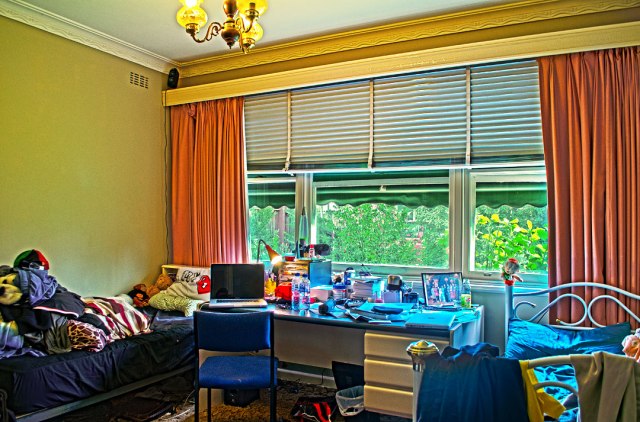
My first experiment with HDR
Not All The Same
For the report, I chose Capture One, Adobe Lightroom and an Adobe plug-in called Camera Raw to compare in terms of both user-interface (UI) and image quality (IQ).
In regard to IQ, Camera Raw and Lightroom give me the same result which provides superb quality, the white balance section works very well and the shadow rendering is flawless. However, I find that Capture One is slightly better than its counterparts in terms of tones, colours, contrast and clarity. In the model portrait, Capture One provides better skin tone and more pleasing colour overall, it’s like it knows what the image was supposed to look like originally and doesn’t distort it too much.
About UI, Camera Raw and Lightroom are fairly intuitive and more accurate with adjustments, probably because I was already familiar with Adobe products; meanwhile, the interface of Capture One offers too much complex interpretation of the raw image data as well as unnecessary tools which are somewhat cumbersome.
Obviously all three softwares do the job admirably, if I had skills with all three softwares I think the result will be probably the same but at this stage, as a photography student, my preference is with Lightroom because it offers me sufficient edits. Indeed it has very flexible import and preset functionality with excellent processing tools. It provides a productive workflow which allows me to work very fast on a large volume of raw files (Camera Raw can’t function because you have to edit and save every single file). Although Capture One gives me better colour correction, tone and clarity, its files management and its rather complex UI still have to climb one step higher to convince me.

![Miss.Kelly[Damn Thinnie]](https://i0.wp.com/farm3.staticflickr.com/2269/2405163087_0d3776bfcb_s.jpg)
![Hot Avril![Don'cha Think So?]](https://i0.wp.com/farm3.staticflickr.com/2235/2405994992_4925482a70_s.jpg)

![Shayne[My Inamorato]](https://i0.wp.com/farm3.staticflickr.com/2113/2509916221_faf9ed37a9_s.jpg)

![Ashley[My Inamorata]](https://i0.wp.com/farm3.staticflickr.com/2302/2510753600_ece06e7062_s.jpg)














